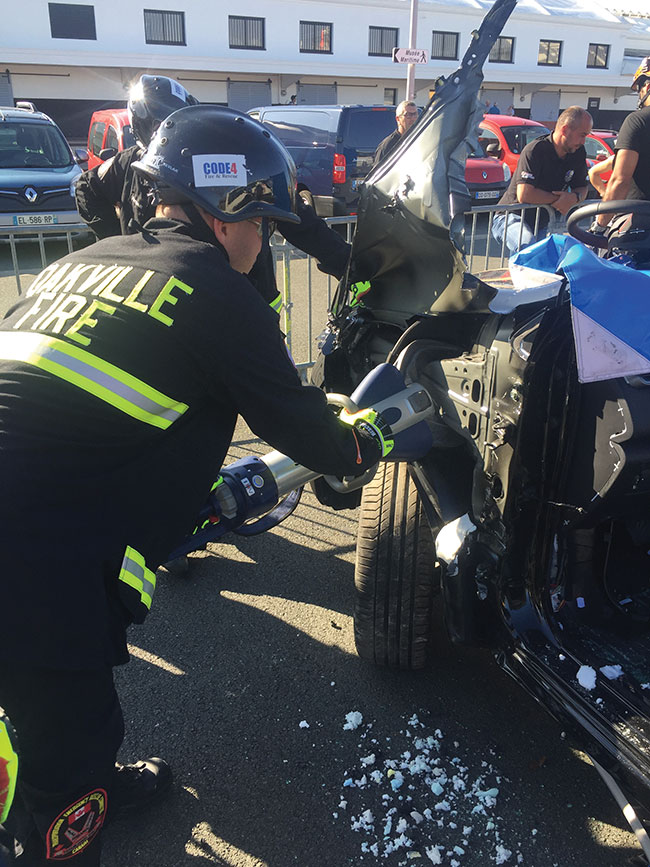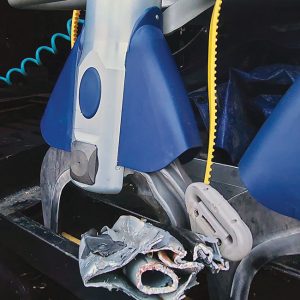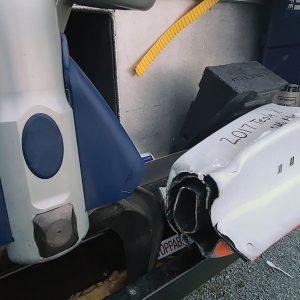
Extrication tips: The evolution of steel
Chad Roberts
Features Extrication Training editors pick High strength steel reinforcement in areas like the lower A pillar make dash relief cuts difficult and lengthy.
High strength steel reinforcement in areas like the lower A pillar make dash relief cuts difficult and lengthy. Through the early ages of auto extrication and up until present day, we as rescuers and those before us have always faced new challenges in the automotive industry. We had the hand tools, then came the come-along and chains. Vehicles got tougher and stronger, so we answered with air chisels and reciprocating saws. Then the age of hydraulic tools arrived, first-hand powered then soon succeeded by the power-driven models. From that day forward, our tools have always been up to most of the vehicle challenges thrown at us.
But, something new has started to make rescuers shake their heads time and time again in modern day vehicle extrication: steel. It’s been in our cars since day one and is going nowhere but up.
To the automotive industry, steel is one of the fastest evolving materials in large part to more recent advances that turn simple steel into a lightweight giant. How did this all happen? Why is it happening and how does it affect us? I’m going to try and sum it all up briefly in the best way I can that will give the general rescuer more understanding of this rapidly evolving material.
First off, let’s address the what, how and why of high-strength steels. High-strength steels are unique lightweight materials that are made up of many different chemical compositions and structures. While there are many varying ranges and types of high-strength steels, they are all generally created by precisely heating and cooling different compounds to ultimately achieve different levels of strength and ductility. Common types of high-strength steels include dual phase, complex phase, transformation-induced plasticity, hot formed, and twinning-induced plasticity. Although different in terms of their microstructure, all of these materials produce one of the greatest challenges in our vehicles today.
Let’s talk about the “why” with high-strength steels. At first glance, one may easily be guided strictly to patient safety. While this does hold true, there are many different reasons for the introduction and continuous evolution of these steels. The first reason is money. Like every company, the automotive manufacturers want to turn continuous profit. To stay competitive, they need to stay reasonably priced. While some manufacturing has leaned towards aluminum body structures to improve weight and fuel efficiency, aluminum is, on average, 60 to 80 per cent more expensive in overall vehicle design cost to the manufacturer. High-strength steels offer a lightweight option that not only contributes to better fuel economy than conventional steels, but are relatively the same cost as the preceding softer steels (less fuel consumption equals less carbon footprint).
Next is ductility, the material’s ability to be shaped. While many different softer steels were introduced to increase ductility to better support more exotic vehicle stamping, they suffered in their lack of strength, which hurt patient safety and therefore damaged ratings and sales. Then, there are hybrid high-strength steels, which are constantly being manipulated to offer great ductility qualities while still supporting the strength qualities for greater patient safety.
With all these different names and types of steels, how do we tell them all apart? High-strength steels can be classified in various ways, to keep things simple, we will classify by strength. The classification of advanced high-strength steels are for materials that yield tensile strength qualities greater than 550 megapascals. Once strength levels reach over 780 MPa, these are now considered ultra-high-strength steels. Finally, we have gigapascal steel, which brings in tensile numbers over 1000 MPa. Just when you thought it was done, you would be wrong, as a third generation of high-strength steels is being produced that will achieve minimum tensile strengths of 1200 MPa.
Why are all of these different levels so important? As easy as it would be to just pick the strongest material, each material boasts different ductility and elongation properties that may be required for different areas of the vehicle, depending on the purpose. To be more specific, dual phase and transformation-induced plasticity steels are more suitable for crash zones as they yield superior energy absorption. Other compositions like martensitic and boron-based hardened steels are very high-strength, which can be very beneficial and often found in passenger compartment areas.
Now that all of the difficult and confusing stuff is out of the way, let’s quickly address some of the issues this will cause us as first responders. First off is the sheer magnitude of strength that is now being combined with better elongation and stamping properties. While we’ve all been accustomed to high-strength rods and tubes being placed in pillars and support structures, we must now be ready to start seeing it everywhere. However, these steels won’t be obvious going forward. They will make up door panels, seat belt components, and even protect our high-voltage batteries. What can we do? Prepare, equip, and educate ourselves. By researching new vehicle structures, we will better understand where these high-strength steels are now being placed. As for equipment, we as rescuers need to push for modern hydraulic rescue tools to address these new steel compositions. Even the finest reciprocating saws with excellent blades will have a tough time against most of these materials. Finally, we need to prepare ourselves for the new reaction that we are seeing consistently with high-strength steels. Cutting steel of the past with first-generation tools was functional, whereas these second and third-generation hybrids are fracturing and breaking with violent reactions that can frighten a patient or rescuer if not prepared. If a chunk or material that is being cut is not supported on both sides, this piece of high-strength steel can become a violent projectile.
As much as this may seem complicated or daunting, as rescuers we must overcome the stark realization that our vehicles are forever changing, now more than ever at a torrent pace. With the continued evolution of high-strength steels, these challenges and difficulties might not be so easy to see right in front of our eyes and leave us thinking, “What was that?”
Chad Roberts is a firefighter in Oakville, Ont. He is a member of the Oakville extrication team and competes and trains across North America. Contact Chad at chadroberts12@gmail.com.
Print this page
Advertisement
- B.C. wildfire crews unable to attend all new fires during ‘unprecedented’ fire season
- Three homes severely damaged by fire in Calgary

